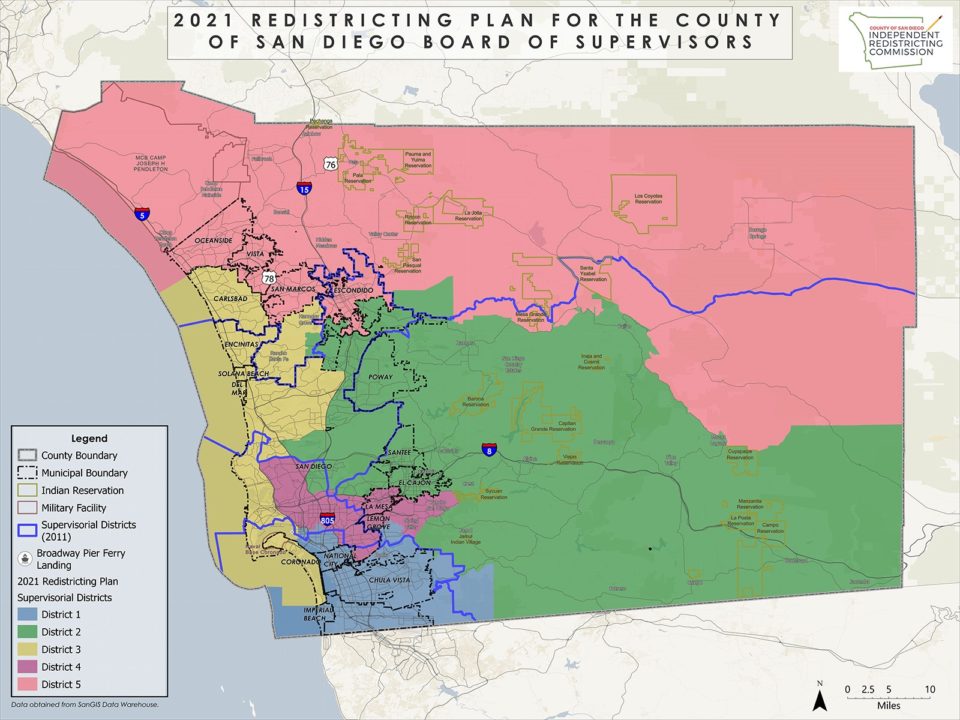Continuing to move Coronado forward is the renewed goal of Mayor Richard Bailey as he withdraws from California’s 52nd congressional race. “The decision to suspend the campaign, after just five months, was not an easy one,” he says.
Every 10 years, California looks at new district boundaries for congressional, senate, state, and county legislative districts. This is based on recent census statistics, which was delayed this cycle due to the pandemic. The commission is made up of five Democrats, five Republicans, and four independents, along with technical staff, including legal experts tasked with forming districts that are non-partisan. The process included creating visualizations in mid-2021, which were pre-draft maps for the public to see and offer comments. When these were revealed, Bailey noted that some options looked promising, while others did not. He says that Coronado was shown in a moderate district, with voters’ views consistent with his platform. At the beginning of December 2021, the commission put forth the actual draft maps for final public comments, and again Bailey felt that certain options looked more promising than others.
“We were hopeful that our district would be more competitive with our views, but that didn’t turn out to be the case, when the final districts were determined,” he comments. Of the 52 Congressional representatives in California, 42 are Democratic, and 10 are Republican, but with the new redistricting, he says that the percentage of registered voters in all but five districts became more Democratic. Even though California has 25 percent registered Republicans, Bailey points out that no seat held by a Democrat went moderate.
The districting decisions were based on a myriad of factors, including looking at partisan registration, demographics, past voting records, and if the district was competitive. Ultimately, he and the campaign team chose not to proceed with the time and money required, when there was no longer a clear path to victory. Bailey wonders why the finalized congressional maps are different from those of the new county supervisor districts. Coronado went from being in District 1, with Supervisor Nora Vargas in the South Bay, to District 3, spanning Carmel Valley to Tierrasanta and Escondido to Encinitas, led by Supervisor Terra Lawson-Remer – see map below.

When asked if candidates suspending campaigns was a common occurrence, he said it is not unusual for candidates to suspend or run for another office, especially when redistricting occurs. When asked if he had a recommendation of who people should now vote for as their Congressional representative in the next election, he noted that candidates have until March to file, so the options are not all in yet. For his own political aspirations, he is waiting to see what the future holds before making a decision.
His passion for advancing meaningful reforms at the local, state, and federal levels, has led him to shift his emphasis to start a statewide political action committee (PAC), which will be a non-partisan unified effort to help qualify repealing Prop 47, often referred to as the Safe Neighborhoods and Schools Act and supporting school choice on the ballot for the next election. The goal is to create an information campaign and reach 600,000 signatures, to get these issues on the ballot for voters to decide in November 2022, and make a positive difference in California.
With growing success, his congressional campaign had raised $525,000, with the vast majority from individual donors. People may be surprised to learn that legally the money does not have to be returned, but Bailey’s campaign is asking each donor what they want to do, and so far, everyone is on board to support his new statewide PAC to help reform needed state policies.
Bailey has a diverse background having worked in corporate finance, and then transitioned into consultancy, specializing in brokering manufacturing contracts for a variety of industries. He was an adjunct professor at UCSD, but walked away in anticipation of his congressional campaign ramping up, but now plans on returning to teaching which he enjoys.
With a renewed focus on his duties as mayor, he is proud of the council’s past accomplishments and is looking towards upcoming priorities, such as improving the Orange Avenue District. “It needs to be updated with a cohesive look,” he comments, and says he would like to see the city work with local businesses and make investments to improve the aesthetics and safety of the downtown. Part of this involves securing the road relinquishment from Caltrans and updating the Orange Avenue Corridor Specific Plan.
Solving the Tijuana Sewage crisis is also a top priority, and he is involved with key players to move solutions forward. “A few small projects have already been started,” he notes, and is hopeful that the government will fund the additional $300 million needed to complete all the projects on the comprehensive $600 million list compiled by the EPA to finally solve this decades old problem. He will also continue to advocate for more local control, and rally against heavy handed policies like the extreme RHNA housing numbers proposed by SANDAG, and a variety of other state mandated policies being imposed on cities.
As the pandemic continues longer than expected, Bailey said that it has been a busy time as Coronado’s Mayor, and he is extremely proud of the positions he has taken on COVID protocols like keeping the beaches open, advocating for small businesses, keeping outdoor spaces, like playgrounds and parks available, and he wants to maintain outdoor dining long term. He says it is rewarding to see that Coronado has the lowest coronavirus cases per capita in San Diego county [Coronado’s current rate per 100,000 population is 8,955 with the next lowest incorporated city being Solana Beach at 10,012] .





